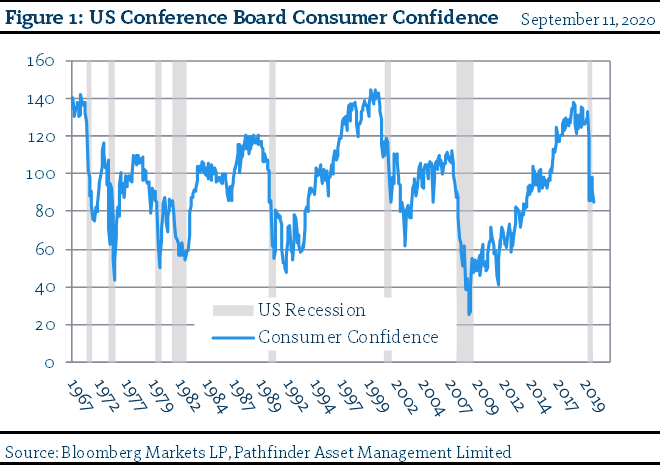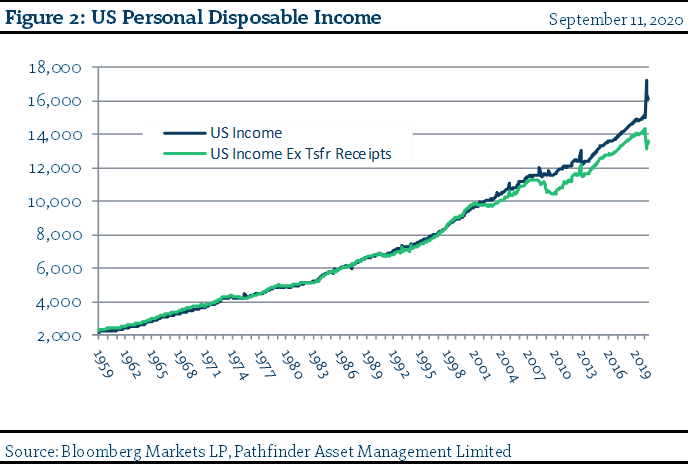We are only part way back
As the pandemic began to make its way across the globe and the recession started, many investors and policy makers put forth a “V shaped” recovery as a hopeful thesis. While this has apparently happened in the stock market, it appears that a different trend in the regular economy is developing. We have tracked a number of indicators in China, Europe and North America to get a sense of how the economy is recovering. China by far and away had the best economic recovery, bouncing back very quickly. Europe and North America are a different case. While Europe seems to be improving on a more consistent basis, North America is somewhat different. In particular, the US, while appearing to have reached a bottom (for the time being?) has come back partially with improvement slowing in recent months. Travel, office attendance, hotel reservations and restaurant traffic seem to be hovering at around 50-60% of what they were before the pandemic and consumer confidence has turned lower again this month (remember the consumer is 66% of US GDP).
- As you can see from Figure 1, consumer confidence, while not as bad as the depths of the Great Financial Recession, has not bounced back from the bottom. We suspect that a substantial portion of this is related to unemployment. While the last few Jobs reports showed gains of 1m jobs per month, we have to remember that cumulatively 22.1m jobs were lost from February to April and we have only gained 10.6m back.

- I found reference to the data in Figure 2 in a presentation put together by Doubleline Capital LP a US bond manager. It shows the gap between disposable income, which includes government assistance and then the same figure with international transfer receipts removed. You can see the two divergent points in 2009 and again in 2020 when the government step in with significant monetary stimulus. Prior to that, both were perfectly correlated. The space filled by the government because of lack of economic activity plays directly into a drop in consumer confidence. People know things have slowed.

“This means that” even with various parts of the economy opening up again, we will still have a long way to go from an economic perspective to return to where we were in January. While there is data that indicates some constrictive recovery, we also have to consider that behaviors will have changed and the fall-on-effects will be somewhat medium term in nature (our opinion).
National Instrument 31-103 requires registered firms to disclose information that a reasonable investor would expect to know, including any material conflicts with the firm or its representatives. Doug Johnson and/or Pathfinder Asset Management Limited are an insider of companies periodically mentioned in this report. Please visit www.paml.ca for full disclosures.
*All returns are time weighted and net of investment management fees. Returns from the Pathfinder Partners’ Fund and Pathfinder Real Fund are presented based on the masters series of each fund. The Pathfinder North American Equity Portfolio and The Pathfinder North American Income Portfolio are live accounts. These are actual accounts owned by the Pathfinder Chairman (Equity) and client (High Income) which contain no legacy positions, cash flows or other Pathfinder investment mandates or products. Monthly inception dates for each fund and portfolio are as follows: Pathfinder North American Equity Portfolio (January 2011), Pathfinder North American High-Income Portfolio (October 2012) Pathfinder Partners’ Fund (April 2011), Pathfinder Real Fund (April, 2013), and Pathfinder International Fund (November 2014).
Pathfinder Asset Management Limited (PAML) and its affiliates may collectively beneficially own in excess of 10% of one or more classes of the issued and outstanding equity securities mentioned in this newsletter. This publication is intended only to convey information. It is not to be construed as an investment guide or as an offer or solicitation of an offer to buy or sell any of the securities mentioned in it. The author has taken all usual and reasonable precautions to determine that the information contained in this publication has been obtained from sources believed to be reliable and that the procedures used to summarize and analyze such information are based on approved practices and principles in the investment industry. However, the market forces underlying investment value are subject to sudden and dramatic changes and data availability varies from one moment to the next. Consequently, neither the author nor PAML can make any warranty as to the accuracy or completeness of information, analysis or views contained in this publication or their usefulness or suitability in any particular circumstance. You should not undertake any investment or portfolio assessment or other transaction on the basis of this publication, but should first consult your portfolio manager, who can assess all relevant particulars of any proposed investment or transaction. PAML and the author accept no liability of any kind whatsoever or any damages or losses incurred by you as a result of reliance upon or use of this publication.